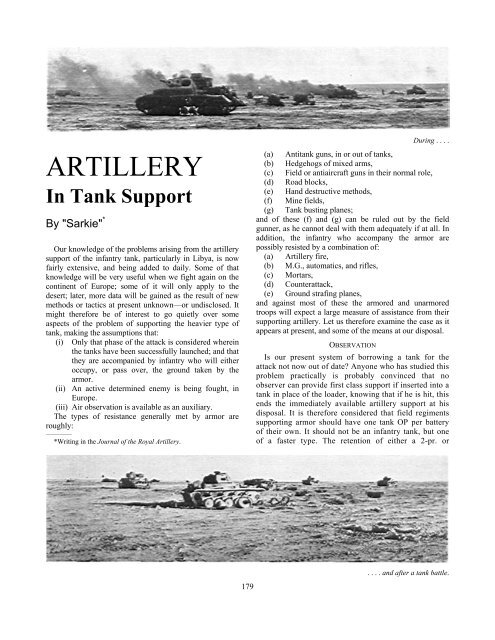the field artillery journal - Fort Sill - U.S. Army
the field artillery journal - Fort Sill - U.S. Army
the field artillery journal - Fort Sill - U.S. Army
You also want an ePaper? Increase the reach of your titles
YUMPU automatically turns print PDFs into web optimized ePapers that Google loves.
ARTILLERY<br />
In Tank Support<br />
By "Sarkie" *<br />
Our knowledge of <strong>the</strong> problems arising from <strong>the</strong> <strong>artillery</strong><br />
support of <strong>the</strong> infantry tank, particularly in Libya, is now<br />
fairly extensive, and being added to daily. Some of that<br />
knowledge will be very useful when we fight again on <strong>the</strong><br />
continent of Europe; some of it will only apply to <strong>the</strong><br />
desert; later, more data will be gained as <strong>the</strong> result of new<br />
methods or tactics at present unknown—or undisclosed. It<br />
might <strong>the</strong>refore be of interest to go quietly over some<br />
aspects of <strong>the</strong> problem of supporting <strong>the</strong> heavier type of<br />
tank, making <strong>the</strong> assumptions that:<br />
(i) Only that phase of <strong>the</strong> attack is considered wherein<br />
<strong>the</strong> tanks have been successfully launched; and that<br />
<strong>the</strong>y are accompanied by infantry who will ei<strong>the</strong>r<br />
occupy, or pass over, <strong>the</strong> ground taken by <strong>the</strong><br />
armor.<br />
(ii) An active determined enemy is being fought, in<br />
Europe.<br />
(iii) Air observation is available as an auxiliary.<br />
The types of resistance generally met by armor are<br />
roughly:<br />
————<br />
*Writing in <strong>the</strong> Journal of <strong>the</strong> Royal Artillery.<br />
179<br />
During . . . .<br />
(a) Antitank guns, in or out of tanks,<br />
(b) Hedgehogs of mixed arms,<br />
(c) Field or antiaircraft guns in <strong>the</strong>ir normal role,<br />
(d) Road blocks,<br />
(e) Hand destructive methods,<br />
(f) Mine <strong>field</strong>s,<br />
(g) Tank busting planes;<br />
and of <strong>the</strong>se (f) and (g) can be ruled out by <strong>the</strong> <strong>field</strong><br />
gunner, as he cannot deal with <strong>the</strong>m adequately if at all. In<br />
addition, <strong>the</strong> infantry who accompany <strong>the</strong> armor are<br />
possibly resisted by a combination of:<br />
(a) Artillery fire,<br />
(b) M.G., automatics, and rifles,<br />
(c) Mortars,<br />
(d) Counterattack,<br />
(e) Ground strafing planes,<br />
and against most of <strong>the</strong>se <strong>the</strong> armored and unarmored<br />
troops will expect a large measure of assistance from <strong>the</strong>ir<br />
supporting <strong>artillery</strong>. Let us <strong>the</strong>refore examine <strong>the</strong> case as it<br />
appears at present, and some of <strong>the</strong> means at our disposal.<br />
OBSERVATION<br />
Is our present system of borrowing a tank for <strong>the</strong><br />
attack not now out of date? Anyone who has studied this<br />
problem practically is probably convinced that no<br />
observer can provide first class support if inserted into a<br />
tank in place of <strong>the</strong> loader, knowing that if he is hit, this<br />
ends <strong>the</strong> immediately available <strong>artillery</strong> support at his<br />
disposal. It is <strong>the</strong>refore considered that <strong>field</strong> regiments<br />
supporting armor should have one tank OP per battery<br />
of <strong>the</strong>ir own. It should not be an infantry tank, but one<br />
of a faster type. The retention of ei<strong>the</strong>r a 2-pr. or<br />
. . . . and after a tank battle.

















